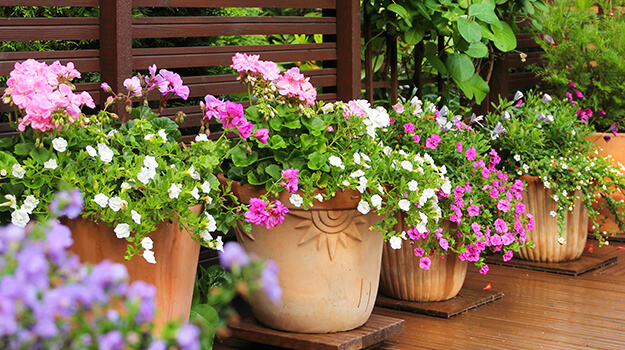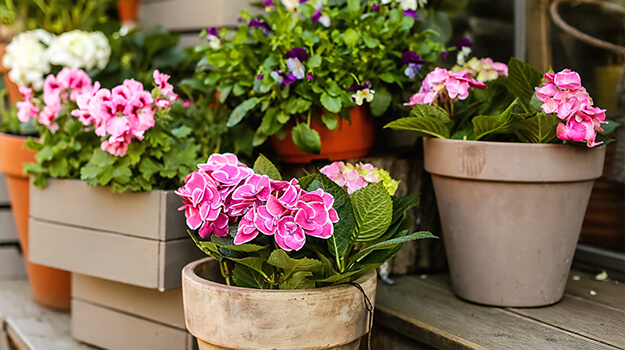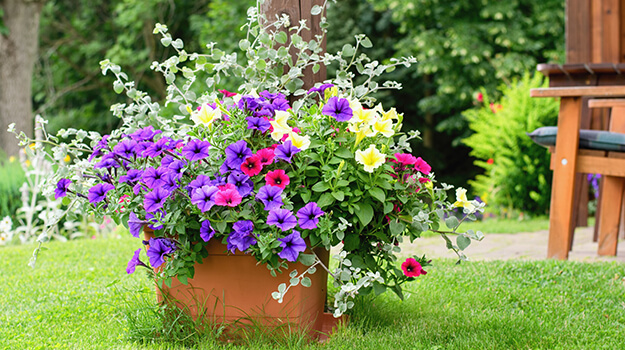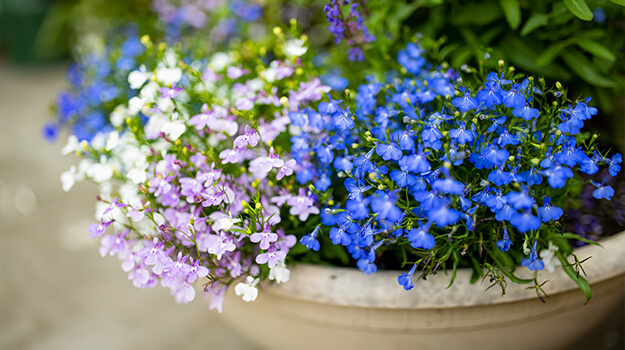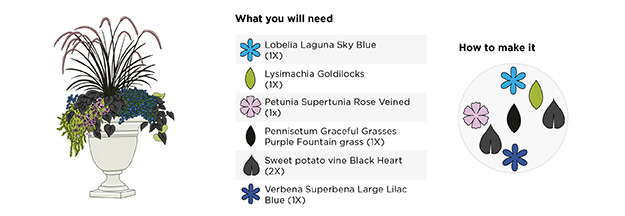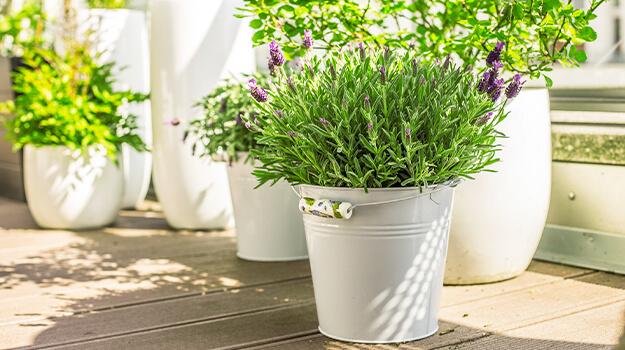- Which flowers should I choose for my planters?
- Plant suggestions for sunny locations
- Flower pots for shade
- Plants well adapted to heat
We love all planters: wonderfully well stocked, on decks and patios, along the paths, suspended from porches and balconies, or hanging from the railings…
With such a wide choice of plants and containers, in all colours and shapes, there is something for everyone. Here are some beautiful inspirations, as well as how to position them to get the most out of your floral arrangements. But first, we need to explain how to choose the right plants for your arrangements.
Which flowers should I choose for my planters?
1. Consider the needs of plants
Winning combinations are primarily made up of plants with similar growing requirements. To coexist well, your plants must, above all, have the same needs in terms of watering frequency and appreciate the same exposure, whether in the sun or in the shade. For example, you should avoid planting a New Guinea impatiens, which prefers to live in the shade in constantly humid soil, alongside a lavender which loves the sun and does not survive with ample watering.
2. Combine shapes, colours, textures and heights
For stunning results, integrate plants with different characteristics into your potted arrangement. For example, consider a tall plant (such as ornamental grass) in the centre or back of the planter, bushy plants beside or in front of the taller plant, followed with cascading plants around the edge. Choose contrasts, pay particular attention to the shape of the flowers, combine oversized foliage with delicate, cut-out foliage.
You already know where you want your planter placed, so take into consideration what kind of exposure it will receive. In the sun, the bright colours look wonderfully vibrant. In the shade, pastel shades can illuminate and add sparkle.
Consider the subtleties present in the foliage, the colour of the container, but also the environment where your composition will be placed. Consequently, a pot placed next to colourful furniture should offer a more sober floral arrangement, a more subtle variation or repetition of the colour of your cushions!
3. Make colour last all season!
For splendid planters throughout the season, choose plants with prolonged flowering. Also look for coloured foliage (gold, red, copper, silver) which will take over splendidly if, for a moment, the flowering runs out of steam!
4. Add decorative foliage
Garden centres are full of plants with exceptional foliage. Pay special attention to them when preparing your arrangements. As you do when choosing your flowers, consider colour, shape, size, texture and habit.
The erect foliage of grasses can be used as the focal plant around which the arrangement is organized. The generous and colourful foliage of hostas and coral bells are perfect for surrounding it since they can be extracted directly from the perennial flower beds. They will expand little during the season but will instantly fill the pot.
Finally, there is a vast choice of hanging plants with colourful, variegated and nicely cut foliage. Some form dense cascades, managing to completely cover your pot in the space of a season.
Here are some great options: ivy, sweet potato, vinca, silver helichrysum, dead-nettle, lysimachia, dichondra Silver Falls, sedum, licorice plant.
5. Visually balance your planter with plants with similar development
To maintain a beautiful balance in your arrangements all season long, no plant should take over the others. Choose varieties with similar growth rates. Ask the staff at your garden centre or consult the labels. If it says that it grows quickly, that gives you a good clue. Avoid combining vigorous plants with compact, slow-growing varieties that will be stunted!
Despite all your precautions, if one of your plants is preparing to overtake all the available space, don’t panic! Just prune its stems so you can easily regain control.
To find out how to arrange your plants and create pots worthy of professionals, read our article: How to arrange potted plants
Sunbathing for planters: plant suggestions for sunny locations
There are so many plants for sunny locations that you will be spoiled for choice. On the pelargonium side (the one we call “annual geranium”), we can choose from a beautiful range of colours, compact or hanging varieties, variegated, or nicely cut foliage.
Flower suggestions for your planters in full sun or partial shade*:
- Ivy geranium (pelargonium peltatum)
- African daisy
- Petunia and surfinia
- Verbena
- Lantana
- Gazania
- Purslane
- Coreopsis
- Euphorbia hypericifolia
- Calibrachoa Million Bells
- Bacopa
- Scaevola
- Helichrysum
- Calocephalus Silver Bush
- Antoline
- Cinerary
*For planters, a partial shade exposure means that your plants benefit from the sun only part of the day: in the morning (east) or in the afternoon (west).
Flower pots for shade
Usually composed of annual flowers, planters often require a good dose of sunlight every day. Is your ideal location for installing a flower pot rather shady? No need to deprive yourself though!
Make sure you choose the right plant varieties so that your shade planters are beautiful and colourful as you hope. The following flowers will make a splash:
- Begonia (choose from varieties with a stocky, drooping or slender shape)
- New Guinea impatiens (choose them for their flowers, but also for their foliage)
- Fuchsia
- English ivy
- Boston fern
- Oxalis
- Browallia
- Coleus (new varieties are available every year in stunning colours)
- Plectranthus (spur flower)
- Dead-nettle (to add colour and texture, look for varieties with variegated foliage)
- Liriope muscari (lily turf)
- Fern
- Chlorophytum (spider plant)
- Helxine (baby tears) for its tiny foliage which covers the base of tall plants)
- Caladium (exotic and colourful as can be!)
Plants well adapted to heat
Some plants tolerate drought well. At first glance, you’ll recognize them by their thick, hairy, embossed or silver foliage. These different characteristics allow them to withstand intense sunlight and heat better than their peers!
Here are some suggestions for plants that are well adapted to climate change:
- Sage
- Lavender
- Sedum
- Aubrieta
- Wallflower
- Nepeta catmint
- Yarrow
- Valerian
- Perovskia (Russian sage)
- Several grasses (pennisetums, sedges, fescue)
Succulents also allow you to create beautifully original arrangements. With their wonderful variety of colours and shapes, jade plants, echeverias, hen and chicks, and Chihuahua flowers are all suitable for creating miniature landscapes that are definitely not lacking in interest!
Ultimately, we can introduce aromatic herbs into our planters. Prized in the kitchen, herbs also have the gift of spicing up floral arrangements with their contrasting foliage. Sage with bluish, golden, variegated or wavy foliage, or green or purple basil, lemon thyme, chives, rosemary… By letting your aromatic herbs bloom, you will receive visits from butterflies and other pollinators!
How many plants to use? What types of flowers to use? How to arrange plants? How to arrange your plants in your potted arrangements for a fabulous result? Find all the answers and other ideas for original compositions in our other article: How to arrange potted plants

